From Floridata
by
Steve Christman
Passiflora incarnata
Common
Names: maypop, passion flower, apricot vine
Botanical
Family: Passifloraceae, the passion flower Family
Description
There are over 400 hundred species in the genus Passiflora. Most
are tender evergreen tropical vines and most are commonly called
passion flowers. Passiflora
incarnata is an exception in that it is deciduous, can
survive winter freezes and is commonly called maypop as well as passion
flower.
Maypop
is a fast growing perennial vine that employs tendrils to grab hold of
adjacent shrubs, structure and other supports to lift itself to heights
of 8-12 ft (2.4-3.7 m). The large serrated leaves grow 5-6 in (13-15
cm) wide by 6 to 8 in (15-20 cm) long. They typically have three to
five lobes and are arranged alternately on the stem with flowers and
branches emerging from the axil (the base of the leaf stem where it
attaches)
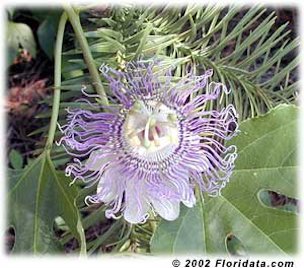
The beautifully intricate maypop flower is a spectacular
sight to behold with a complex structure fraught with
religious symbolism.
All
of the passion flowers have beautifully complex blossoms and maypop is
no exception. These have 2-3 in (5-7.6 cm) diameters and are composed
of 10 white tepals arranged in a shallow bowl shape above which is
arranged fringe of purple and white filaments, called the corona. In
the center is the white fleshy stigma surrounded by five stamens.
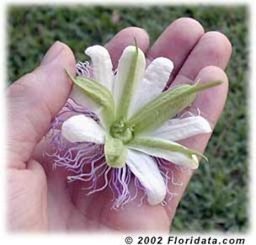
This is the underside of a passion flower. Notice
that alternating tepals are green, these being
the sepals that enclosed the bud before blooming.
Tepal is a term used for both petals and sepals
when the sepals are modified to resemble the
actual flower petals.
Location
Maypop, Passiflora
incarnata,
is native to southeastern United States and is often seen growing on
the edges of fields, along side ditches and other sunny, moist and
fertile places.
Culture
Light: Full
to part sun.
Moisture: Light,
evenly moist soil; mulch well.
Hardiness: USDA
Zones 6 - 9. Dies back to ground in winter but recovers in spring.
Propagation: Seeds,
cuttings.
Usage
Grow
maypop vines on fences or trellises or allow it to scramble over shrubs
and trees. Every year maypops appear beneath my blue China firs (Cunninghamia lanceolata)
The vines grow a foot or two and use their tendrils to climb from
branch to branch to about 10 or 12 feet until frost kills it back to
the ground. The buds open one by one beginning at the oldest part of
the vine and proceed sequentially along its length. This is smallish
but rather rowdy vine that tends to grow every which way and therefore
looks best in natural and informal plantings. Maypops are mostly pest
free but are sometimes devastated by caterpillars - which is a good
thing if you like butterflies. The gulf fritillary is especially fond
of this plant. Mature fritallaries deposit pinhead sized orange eggs on
the leaves that hatch into ravenous caterpillars that will put the bite
on the vine in short order. By permitting the maypop vines to scramble
over shrubs you can share with the butterflies and enjoy the showy
flowers while the support plant's foliage camouflages the caterpillar
clobbered leave.
Features
The
maypops are the size of a small hen's egg with yellow-green skin juicy,
but seedy pulp. Indeed, it is the fruit of a related species (P. edulis)
that gives Hawaiian Punch® its distinctive taste. Unfortunately I've
never actually tasted a maypop! This is because the fruits should be
left to fall from the vine to insure that they are ripe and invariably
some other hungry creature finds them before I do! They are said to
taste a lot like guavas which I don't like anyway! (... does that sound
like sour grapes... er, maypops?)
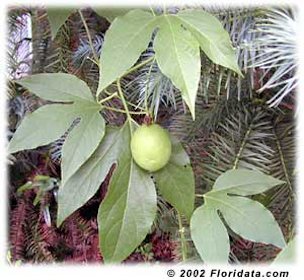
The fruits of this species of passionflower are called
maypops and are about the size of an apricot and have
a similar, but stronger and more aromatic flavor (like a guava).
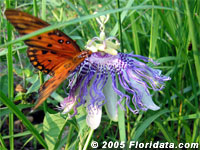 |
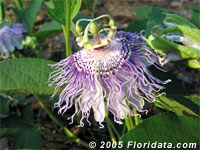 |
Gulf Fritillary butterfly on a maypop
blossom |
Maypop
flower |
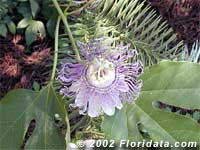 |
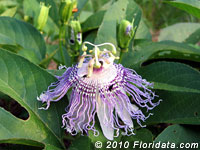 |
| Maypop blossom |
Maypop flower |
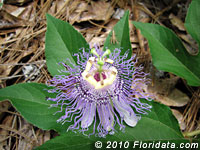 |
| Maypop flower |
|
|
Bibliography
Christman,
Steve. "Passiflora
incarnata." Floridata, no. 77,
Published 1 Dec. 1996, Updated 3 Jan. 2001, 11 July 2002, 23 Aug. 2003, floridata.com/plant/77.
Accessed 15 Feb. 2021.
Published 15 Feb. 2021 LR
|







